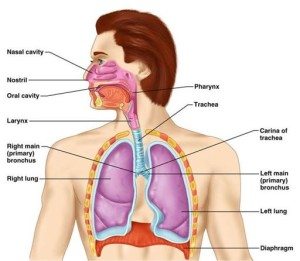Respiration and speech
The speech mechanism is complex and involves coordination of various body systems. The Respiratory system plays a key role in speech production.
Respiration has two cycles, Inhalation and Exhalation. When we inhale, we use our muscles to lift and rotate our ribs slightly, hence expanding the chest ( thorax) in which lungs are situated. Simultaneously, the diaphragm ( that is the muscular floor of the chest) lowers, further expanding the thorax. This thoracic expansion creates a negative pressure or vacuum inside the chest. As a result, air flows in through the mouth and the nose down to the throat (pharynx), between the vocal cords in the larynx , down the trachea and finally reaches and inflates the lungs.

When we exhale, all the muscles that help in inhalation should relax or contract. Relaxing the contracting muscles of inhalation allows the rib cage to come back in its resting position, and hence allows the compressed abdominal structures to expand. Our chest begins to contract and air begins to exit from the lungs.
Read some more blogs on Top 5 vocal exercises for vocal professionals
When we are breathing for speech, we inhale more quickly and deeply. We also don’t quickly exhale. Instead after inhalation we tend to control the exhalation of air precisely to maintain the right airflow that is needed to drive speech.
Speaking involves complex respiratory adjustments. Speaking faster, louder and with different pitches complicates this all the more. Hence children with breathing difficulties such as asthma or emphysema may face more challenges while speaking effectively
